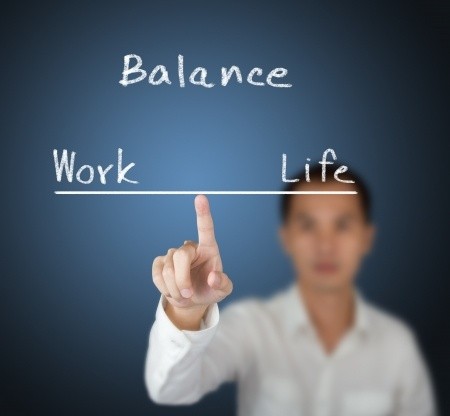
(Full disclosure: I was compensated by National Rental Car, but the words and strategies are my own longtime takes on the importance of time off to time on and life fully lived.)
The worst boss in the world can sometimes be the one looking back at you in the mirror. We can push ourselves far beyond what’s healthy or needed, and when it comes deprivation, oh, yeah, we are darn good at that. We’ll get to life later, when everything is done, when there’s an opening in the schedule, when we reitre. Enter the life postponement habit.
The basic gist of it is that we’ll get to the living part in a future that never arrives. Yet work-life balance isn’t a destination in another tense. It’s something you participate in along the way. Compartmentalizing downtime as something you can put on a layaway plan or only indulge in when the to-do list is done leaves lots of living on the table.
THE LIFE MANDATE
Taking advantage of your free time along the way is a wise thing to do since it is the point of the work we do, anyway—the living we’re making for ourselves. It’s also what our brains and bodies demand, recharging us and helping us recover from the strain that piles up during the day. Plus, it’s what our brain neurons want—engagement with the world, which satisfies core psychological needs and makes us feel great.
And, last but not least, striking the right balance between work and down time is how we’ll ultimately have the right answer to one of the three main questions psychologist Erik Erikson said we will have at the end of our years. Was it a good time?
Researchers say we put off things we don’t value, so if we agree that the life side is valuable, it may be time to make our life mandate more top-of-mind. We could start by celebrating the time we take for life and work-life balance during the week, on the weekend, or even on business trips. How about keeping a Life Log of the opportunities we take each week to experience something fun or relaxing and get-togethers with others? Write them down. Take a few seconds to savor them.
NATIONAL’S FREE RENTAL DAY FREES UP WORK-LIFE BALANCE
Some people are in a perfect position to jump-start work-life balance. I’m talking about business travelers, who have a special opportunity to live-as-they-work by exploring the places their work takes them.
National Car Rental offers an annual program that makes it much easier for road warriors to squeeze in some balance around business. National’s One, Two, Free promotion provides its Emerald Club members one free rental day for every two qualifying rentals. A free rental day can provide the spark you need to step back from the game face of business and experience the benefits of lingering a bit—to enjoy travel discoveries, new folks, and adventures, because life happens when you’re not rushing past it.
I found the concept of the free day via a free car rental compelling enough that I decided to help get the message out about this opportunity to grab life highlights amid the workweek. Most of us need an incentive to change ingrained habits. The free rental day every two qualifying rentals (many of our business trips include two consecutive rental days), can be that prod and jumping-off point to a national conversation about how we can build more work-life balance into our busy lives. It’s as simple as joining National’s Emerald Club and registering for the One, Two, Free promotion.
Consider it a catalyst to override the time-urgent rut and explore local historical sites, cultural hubs, or recreational offerings. On my business trips, I’ve done everything from taking a salsa dance lesson at an Arthur Murray dance studio at a strip mall in the burbs of Washington, D.C. to seeing awesome live jazz at Dizzy’s in New York City, to a side trip to Bandelier National Monument outside Santa Fe.
7 WAYS LIFE POWERS PERFORMANCE AND HAPPINESS
Whether you take a free hour after a meeting or a half-day or extra day for sightseeing, the science shows it’s well worth the time on so many levels:
1) You break up the source of stress and get psychological detachment, which allows your brain and body to recover from strain and the rumination that drives it.
2) You increase positive emotions. The University of North Carolina’s Barbara Fredrickson reports that we need three positive events to every one negative to stay on the positive side. Side trips can pack in the positive moments that crowd out the negative.
3) Engaging activities, such as exploring through travel, build self-esteem and confidence, along with one of your core needs, competence. Discovering an interesting attraction puts you in the driver’s seat to satisfy that need.
4) You improve optimism, a key to health, performance, and rapport, and squeeze out the negative track of pessimistic thinking by indulging in satisfying leisure experiences.
5) Play boosts the immune system and vitality, refueling our energy.
6) Recreation activities and pursuits increase attention by focusing your brain on a target, be it the rules of an activity, the grandeur of a vista, or the story behind a museum exhibit. All can boost your concentration.
7) You improve risk-taking skills. We tend to try new things when we are out of our normal setting. Your brain loves novelty and challenge and releases dopamine, the elixir of satisfaction in the brain, to celebrate them.
When we get too caught up on the professional side, we forget that quality output depends on quality input, i.e. recreation and recharging. We know that play resets the brain by producing unpredictable thought associations that can unblock stuck gray matter. That’s why we have that old expression, “If you haven’t had a day off, you haven’t had a day on.”
TOO BUSY TO LIVE?
Two big obstacles stand in the way of taking advantage of business travel life opportunities: stress and time frenzy. Stress suppresses the play equipment in our brains, keeping the mind distracted by ruminative loops and catastrophic thoughts.
Get around this by planning both sides of your trip—the work and the opportunities for fun—ahead of time. Identify potential activities or side trips and lock in a commitment from yourself upfront. Line out your work objectives and your life objectives for the trip. What can I discover? What can I learn? What can I see?
Laser-focus on time as only a business currency rules out use of it on the life side. We wind up with the I’m-too-busy-to-deviate-for-one-second mentality. Prioritize your life time as you would your to-do list. Switch off the time frenzy once your business tasks are completed. Then turn to a different mind-set, one that is not about results but about experiencing fun or learning for its own sake. This provides a powerful inner reward by gratifying a core need.
A very close friend of mine went to work one day in January and never came home. It was a powerful reminder that now is the time to start activating living time. Because tomorrow is too late.
Let’s get out there and live!



















